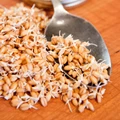
Farro Monococcum, which is also known as Einkorn, Small Farro, and Little Spelt, is the oldest grain that exists even today. First to be domesticated, about 10,000 years ago, has been found in Egyptian Tombs and is also believed to have sustained the Roman Regions.
From 44BC to the collapse of the Roman Empire in 476, Farro has been quite famous among the Romans. Remnants of einkorn were found with the iceman mummy Otzi, dated 3100BCE. Because of its affordability, the poor population of the Roman Empire used ground Farro to make various dishes.
‘Arisab’, as mentioned in Hebrew, is used to make the national dishes of Lebanon, Libya, and Middle Eastern countries even today. The only difference is that it is known by different names like Taboule, Kibbe, and Salf. Cooked faro looks and tastes like barley, with a slightly more chewy texture and caramel notes, and is also available in different types, but Farro Monococcum is the oldest.
Farro is rich in fiber, magnesium, and vitamins A, B, C, and E. It thrives in arid, high-altitude areas and is never cultivated with chemical pesticides and fertilizers. It is mostly consumed by people having gluten intolerance because it is easy to digest and has low gluten content. Just one cup of whole-grain farro can provide 20% of the daily recommended fiber intake. This fiber-rich food grain can prevent blood sugar spikes and might even help in reducing bad cholesterol. Just ½ cup of Farro contains 12 grams of protein.
Einkorn is a diploid species of hulled wheat with tough glumes (husks) that tightly enclose the grains. The cultivated form is similar to the wild, except that the ear stays intact when ripe and the seeds are larger.











